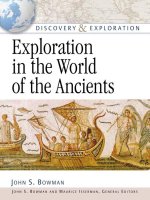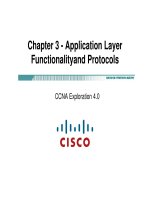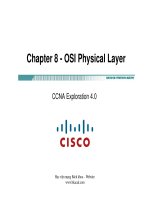GEOL GEOCH EXPLORATION
Bạn đang xem bản rút gọn của tài liệu. Xem và tải ngay bản đầy đủ của tài liệu tại đây (1.48 MB, 97 trang )
GEOLOGICAL AND GEOCHEMICAL
EXPLORATION
Dr. Ahmed Ali Madani
Associate Professor
Tel. (off.): 64324
E-mail:
Overview of Exploration Geology
Exploration geology is the process and science of
locating valuable mineral or petroleum deposits,
ie, those which have commercial value.
The term “prospecting” is almost synonymous
with the term “exploration”.
Mineral deposits of commercial value are called
“ore bodies” (compared to commercially viable
deposits of oil which are called “oil fields”).
This course will be focused largely on mineral
exploration, although many of the same
techniques are used in petroleum exploration.
The initial signs of potentially significant
mineralization are called “prospects”.
Through the exploration process, the prospect is
investigated to acquire more and more detailed
information.
The goal is to prove the existence of an ore body
(or oil field in the case of petroleum exploration)
which can be mined (or “developed”).
The exploration process typically occurs in stages,
with early stages focusing on gathering surface
data (which is easier to acquire), and later stages
focusing on gathering subsurface data, including
drilling data and detailed geophysical survey data.
Determining the value of an ore body (or “deposit”) requires
determining two main features: 1) “tonnage” (or volume),
and 2) “grade” (or concentration).
The volume is determined by using drill data to outline the
deposit in the subsurface, and by using a geometric models
to calculate the volume. If the ore body is exposed at the
surface, then the dimensions of length and width can be
gathered at the surface, possibly with the aid of some
trenching or blasting methods. However, most of the
volume which must be defined is typically located at depth
and requires the use of extensive drilling or underground
excavation methods to define. The volume is difficult to
delineate because ore deposits often have irregular shapes.
The “grade” is the average concentration determined from
numerous assays of drill samples. The grade can vary
considerably within different parts of the same ore body.
Development usually consists of extensive, close-spaced
drilling which outlines the geometry of the deposit in
great detail. The development stage will also conduct
extensive testing, with some preliminary metallurgical
testing, to precisely determine grade of the deposit and
the “recovery” (the amount of metal possible to extract,
compared to the total amount of metal present in the
ore body). The final stage before actual mining or
extraction is called “feasibility”. During this stage, the
actual mining or extraction method is proposed, taking
into consideration all of the economic variables which
effect the bottom-line profit (commodity price, milling
cost, transportation cost, labor cost, etc...). At this
stage, a decision is made whether to mine the deposit
from the surface (called “open-pit mining”), or to mine
the deposit by tunneling (called “underground mining”).
Mineral seldom occur at the surface and are seldom
obvious.
Most often they are buried, sometimes at considerable
depth.
Since they are not visible we must detect their presence
indirectly and extrapolate between points where data is
known.
Many different techniques can be used to detect an ore
body. This class will discuss the more important techniques
in some detail; others are only briefly mentioned.
The most important techniques used in exploration
geology include geological field methods, geochemical
sampling methods, and geophysical methods. Exploration
conducted from the surface is far less expensive than
drilling or underground excavation, so thorough surface
exploration usually precedes either of these activities.
The Exploration Process
Exploration for a mineral deposit is usually conducted in a
step-wise fashion which progresses through stages, each of
which moves closer to making a valuation of the ore body.
Geological reconnaissance and surface geochemical sampling
prevail in the earliest stage. Simultaneously or afterwards,
geophysical surveys are typically conducted. Following
surface exploration, the project moves into the drilling stage.
Drilling may begin with a small number of exploratory drill
holes on select targets. After this drilling stage, extensive,
close-spaced drilling (called “development drilling”) is
conducted. Finally, pending good results, “reserve drilling” is
conducted, which is the type of drilling which makes the final
assessment of the deposit before actual mining begins.
Generally, some amount of drilling will continue throughout
the life of the mine, as further definition is required and new
information is obtained and used to refine the deposit model.
Exploration Methods
If bedrock is exposed anywhere at or around a prospect,
then surface bedrock mapping is an essential beginning step
for an exploration program. This would include mapping
and sampling (field geologic methods). This work focuses
on identifying and mapping outcrops, describing
mineralization and alteration, measuring structural features
(geometry), and making geologic cross sections.
Geochemical methods involve the collection and
geochemical analysis of geological materials, including
rocks, soils and stream sediments. The results mapping and
sampling may suggest patterns indicating the direction
where an ore deposit could be present underground or at
the surface. Geophysical methods focus on measuring
physical characteristics (such as magnetism, density or
conductivity) of rocks at or near the earth’s surface. The
measured values are then used to compare with the values
and models of known ore deposits.
EXPLORATION GEOLOGY TERMS
Ore: the rock material or minerals which are mined for a profit.
Ore Minerals: the specific minerals within the ore which contain the metals to be
recovered.
Gangue Minerals: the minerals having no commercial value, they just happen to be
mixed up with the ore minerals.
Prospect: potential ore deposit, based on preliminary exploration.
Mine: Excavation for the extraction of mineral deposits, either at the surface (open pit
mine) or below (underground mine).
Orebody or Ore Deposit: naturally occurring materials from which a mineral or minerals
of economic value can be recovered at a reasonable profit.
Mineral Deposit: similar to an ore deposit, but is implied to be subeconomic or
incompletely evaluated at present.
Mineral Occurrence: anomalous concentration of minerals, but is uneconomic at present.
Grade: this means the concentration of the substance of interest, usually stated in terms
of weight per unit volume.
Cut-off Grade: the lower limit of concentration acceptable for making a profit when
mining.
Host Rock: the rock lithology (type) which contains the ore. May or may not comprise
ore.
Country Rocks: the rocks of no commercial value surrounding the host rocks and/or the
ore.
Anomalous: above or below the range of values considered to be normal.
SAMPLING AND CALCULATION
OF TONNAGE AND GRADE
Geochemical Sampling Methods
Geochemical sampling methods are methods which involve collecting and
analyzing various types of geological materials (such as soils, stream
sediments and rocks) or certain biological materials (such as plants).
Historically these methods have been some of the most productive in of any
methods used in mineral exploration. Sometimes mineralization can be
extremely subtle, if not impossible to recognize, in hand specimen. Without
the use of geochemical sampling methods, many known ore deposits would
probably not have been discovered.
After discovery, geochemical sampling plays a key role in the delineation of
mineralization. For example, geochemical sampling of soils is often
employed to outline the general distribution of mineralization at shallow
depths where outcrops of bedrock are minimal or nonexistent. The
procedure involves collection of materials in the field, laboratory (or field)
analysis of the geochemistry of the materials, plotting of the geochemical
values on maps, and interpretation of the results. The materials may be
analyzed for any number of elements. Which elements are chosen for
analysis depends on budget, the geology of the area, and the commodity
which is being sought after. Often there are specific elements or suites of
elements which are known to be associated with specific types of
mineralization. Therefore it is possible to evaluate the potential for the
existence of certain types of mineralization by evaluating which elements
are associated in a given area.
Rock Sampling
Rock sampling reveals the true potential of an area for containing a mineral
deposit. An anomaly in a rock sample from bedrock has had no effects of
secondary dispersion, so the location of the sample is the location of the
source. A rock sample anomaly will provide much more valuable
information about the location of the mineral deposit because its source is
within the mineralizing system, ie, it helps delineate the zone of primary
dispersion. However, this applies only to rock samples collected from
bedrock. Rock samples of float (rock material suspended in colluvium with
no indication of proximity to the bedrock source), talus, glacial material,
etc... give no indication of location of the source, so even if they are highly
mineralized, they are of limited value. Rubble (rock material suspended in
colluvium and due to consistency or other information suggests proximity
to the bedrock source) in some cases may be worthwhile to sample.
Several different types of rock samples are collected for mineral
exploration.
Most importantly, rock samples are collected to determine
the concentration of metals, including both the major and trace metals.
This type of sample is most commonly referred to as a “geochem” sample.
Trace metal values are often useful as “pathfinders”, which means they are
closely associated with the metal of interest and may occur within a halo
surrounding the mineralization of interest.
Rock geochem samples are collected in different
manners depending on the goal of the sampling.
The principle types include:
Grab Samples: A grab sample is a sample of rock
material from a confined area (< 1 foot across).
It can be a single piece of rock.
These are the most common types of samples
collected. If it is not specified otherwise, one
usually assumes that is the sample type.
The sample usually consists of a single piece of
rock, or chunks (large piece), which are
representative of a specific type of rock or
mineralization.
•
•
•
•
Composite Samples: A composite sample consists
of small chips of uniform rock material collected
over a large area (generally > 5 feet across).
These are the ideal “representative” samples.
The procedure is to collect small pieces of rock over
a large area (usually at least 10 feet across) and to
make the sample as homogenous as possible.
A composite sample might be collected to
determine the background values of trace elements
in a particular type of rock, or to determine if ore
grade mineralization is present over a large area.
•
•
•
•
•
High Grade Samples: A high grade sample consists of
selective pieces of the most highly mineralized material,
in which an effort is made to exclude less mineralized
material.
Consequently, a high grade sample is generally not
representative of the overall mineralization type.
A high grade sample might be collected to get an idea
what the best possible values are, or to provide material
for certain types of trace element analyses.
If a such a selective sample does not return good
results, then it is unlikely that valuable mineralization is
present.
When a high grade sample is collected it is important to
note that it is a high grade sample so its values will not
be misinterpreted as representing the “average” values.
•
•
•
•
•
Chip Channel Samples: A chip channel sample consists of small chips
of rock collected over a specified interval.
The objective is to obtain the most representative sample possible for
the specified sample interval.
Most of the time chip channel samples are collected in succession
along a sample line which is laid out in advance using a tape.
This provides a great deal of information about the width and other
aspects of the geometry of a mineralized zone. Often the chip channel
samples are collected along the floors or walls of trenches or adits.
When chip channel sampling along walls, sometimes a piece of canvas
or plastic is laid out for the material to fall on so as to avoid
contamination and make the collection easier.
The freshest material possible is sampled, preferably chipping directly
from bedrock. Sample intervals are set at a specified width, usually
ranging from 1 to 20 feet. For example, in a five foot interval, at the
end of the first foot, 20 % of the sample bag should be filled, at the
end of the second foot the bag should be filled to 40 %, etc... Due to
the method of sampling, chip channel samples tend to be rather large
(up to 20 pounds for a five foot interval).
Several other types of rock samples are
sometimes collected to help interpret the history
of mineralization in an area, to better understand
the relationships between different ore minerals,
or to determine more detailed geochemistry.
These types of samples are often collected to
evaluate the mineralization in a regional context,
or to compare the mineralization with models
which might apply to a given situation. Although
they can might be costly, the
information they provide can be invaluable.
Some of these sample types include:
•
•
•
•
•
•
Whole Rock Major Oxide Samples: Whole rock major oxide samples
are most often collected to study the whole rock geochemistry of
plutonic and volcanic rocks.
The sample must be completely fresh, unweathered, and unoxidized.
If necessary the weathered rind must be removed by chipping or by
using a rock saw.
Samples must also be unaltered by hydrothermal alteration (this adds
new components and removes others, such that it will no longer
represent the parent magma composition).
The sample is analyzed for the principle oxides, including, SiO2, Al2O3,
CaO, Fe2O3, FeO, K2O, MgO, MnO, Na2O, P2O5, TiO2. Usually at least
98 % of the rock is made up of minerals comprised of some
combination of these components. Not uncommonly igneous rocks
contain up to 1 % water. This water is lost when the rock is oxidized
in the furnace (referred to as LOI or “loss on ignition”).
Major oxide analyses are used to classify igneous rocks based on their
chemical composition. These can be used to compare intrusions within
a district or to use in regional studies by comparing the analyses with
those for known models.
•
•
•
•
•
Age Date Samples: Age date samples are used to determine the age of the rocks.
There are several methods, including 40Ar/39Ar, U/Pb, K/Ar, Rb/Sr, and Carbon 14.
They are all based on the half life theory, which states that certain isotopes of
certain elements decay to radioactive daughter products at a specific rate, called a
decay constant. Knowing the constant, the amount of parent and daughter product
material in the sample is measured and then used to calculate the age of the rock.
The 40Ar/39Ar method can provide reliable age dates up to several hundred million
years. Argon gas forms by decay of potassium and gets locked in the crystal lattice.
The U/Pb method is also quite reliable, and can be used to date rocks up to billions
of years old. Older rocks have longer histories, and during those longer histories
more events can occur which cause problems. For example, metamorphism and
tectonic activity. These can cause opening of the crystal lattice of the mineral being
dated, and loss of the daughter product material, causing erroneous results.
Typically these effects cause the methods to yield ages which appear to be younger
than the actual age of the rock. Minerals can also obtain overgrowths during
remelting events, causing excess parent material to be present, also making the rock
appear younger. Ar-Ar and U-Pb age dates can be obtained can be obtained from
very small amounts of material. The procedure involves separating the grains of one
mineral type to be dated. Ar-Ar age dates are usually obtained on minerals such as
mica or hornblende. U-Pb age dates are usually obtained on zircon or other
accessory minerals which are known to contain small amounts of uranium.
•
•
•
Petrographic Samples: Petrographic samples are collected to
conduct thin section petrographic analysis of the rock, which is
the identification and evaluation of the minerals comprising the
rock by using a microscope equipped with both plane and
polarized light.
A thin section is made of the rock, which is a paper thin slice of
the rock mounted on a glass slide. Different minerals have
different optical properties when the plane light or polarized
light is transmitted through the thin section. Textural
relationships also become apparent, which provides
information about the order of crystallization (or paragenesis).
The proceedure is to cut a flat side and use special epoxy to
glue the piece of rock called a plug, to the glass slide. Thin a
special trim saw cuts off the part opposite the glass. Then the
rock wafer is polished with special grinders to achieve the
desired thickness. The thickness must be very precise to
compare the optical properties with known standards.
Fluid Inclusion: Fluid inclusion samples are typically samples of
quartz (others include fluorite, sphalerite or tourmaline). The
samples are prepared similar to a thin section, and examined
using a special microscope equipped with a heating stage.
The inclusions can contain solid, liquid or gas, or any
combination of these. The inclusions are formed when they are
trapped on the surface as a new layer of the mineral
crystallizes. As the mineral cools down, the phases separate.
The sample is heated gradually while being examined under the
special microscope to find the temperature at which the gas or
solid crystal in the fluid inclusion will goes back into solution.
This provides valuable information about the temperature and
pressure of formation of the ore forming fluids.
Polish Section: to look at reflected light properties of ore
minerals; ie, sulfide and oxide minerals.
Microprobe: highly sophisticated method to determine mineral
compositions and textures using electron beams.
SAMPLE TYPE
When the Assay category is chosen, the sample type must be identified using
one of the following:
BULK Bulk - a large volume sample collected from one or more sites for
assay or metallurgical testing. It includes limited sampling or mining in
initial production stages for plant site and operations testing.
CHIP Chip - a large number of small chips or specimens collected over a
specific area.
CHNL Channel - a sample of all material collected from a channel of
specific dimensions across a sample site.
DIAD Drill Core - a split or other type of drill core sample.
GRAB Grab - a single sample normally selected to represent either high or
low grade material.
ROCK Rock - this may be a chip, channel or grab sample which has been
analyzed by standard geochemical techniques rather than assay
techniques.
TRNC Trench - a sample taken from a trench.
****Unknown - This may only be used when the data is important and
needs to be included but the sample type is not known.
Exploration Project Planning
The extensive effort, high costs, and
short field season require a great deal of
planning for an exploration project to be
successful. Details pertaining (relate)
to the logistics of transportation, field
camps, geological surveys, field
equipment, communications, and
emergency procedures are some of the
more important aspects which must be
considered.
Transportation
Many field projects in remote areas require the use of transportation by fixed-wing aircraft or
helicopter, which are the most expensive forms of transportation. Fortunately there are
numerous short, but sometimes crude, airstrips around the state, particularly in the known
mining districts. There are also many airstrips on private land, which might be used if permission
can be obtained. Other areas may have airstrips built for hunting and fishing access, but if these
are maintained by private individuals, permission should also be obtained, even if they are
located on public land. The right type of airplanes equipped with the right kind of landing gear
(large tires) can utilize gravel bars along some of the major rivers. Floatplanes can access the
larger rivers as well as lakes in some areas. Rates for air travel by small fixed-wing aircraft range
up to a few hundred dollars per hour.
Helicopters are the ultimate transportation method for remote areas, but are also much more
expensive, typically ranging from $500 to $800 per hour depending on the type of helicopter
used. The most commonly used types are the Bell Jet Ranger and the Hughes 500, but several
others are also available and suitable for remote work. The Hughes 500 has a reputation for
ability to land in very tight spots due to the greater height and shorter span of the rotors. The big
advantage to the use of a helicopter is the small landing area needed, which means they can be
used to mobe gear and personnel to camps in very remote locations. The helicopter can be used
to drop off geologists at the beginning of the day at locations high on ridges, which would
otherwise take many long hours of uphill hiking to access. Then the geologist can design their
daily reconnaissance traverses to cover a much larger area and obtain many more samples.
Various types of boats can also be used for transportation in remote settings. Airboats are
particularly advantageous in shallow, inland river settings because of the minimal water depth
needed.
If a project is fortunate enough to be on a road or trail system, 4-wheelers, or even 4-wheel drive
vehicles, may be used. The use of these vehicles can provide great cost savings when considering
the larger area which is made accessible.
Field Equipment
Numerous equipment items are necessary to conduct geological field work. Table 15 – 1 is a
partial list of equipment items. Obviously each different type of work activity requires a
different selection of work-related equipment. For example, claim staking requires different
equipment than geologic mapping, and stream-sediment sampling requires different
equipment than soil sampling. It is the responsibility of the field geologist or assistant to
make sure they depart for the field with everything they need to conduct in an efficient
manner the work they set out to do. It is also their responsibility to make sure they have the
items necessary to ensure their safety and comfort. This means they need to carry an
adequate food and water supply. If the logistics call for a helicopter pick up, they should plan
for the possibility that weather or mechanical problems may prevent the helicopter from
picking them up when and where planned. They may need to carry a tool such as a brush ax
or saw to create a landing zone (or “LZ”) for the helicopter.
Personal Comfort & SafetyWork-RelatedGood raingear (jacket & pants)Large pack w/ good
support systemWarm hat & glovesRock hammerWork glovesSmall shovelWater supplySample
bagsFood supplyWaterproof markerGood leather boots (rocky areas)PencilGood rubber boots
(wet areas)Field notebookWarm jacketMineral I.D. kitFirst aid kitHand lensToilet
paperBrunton compass &/or Silva Ranger compassGun & ammunitionHandheld GPSBear
sprayHip chain and threadCowbell &/or whistleField maps & navigation mapsSun hatBrush ax
or macheteBug dopeColored pencilsMosquito headnetPlastic garbage bag (for wet
samples)Signal mirrorFluorescent spraySunglassesTapeWaterproof matches or lighterPick
axRescue blanketHandheld radio w/ extra batteryPocket knifeExtra AA batteries for
GPSParachute cordField vestWater filterGold pan Sample tags









